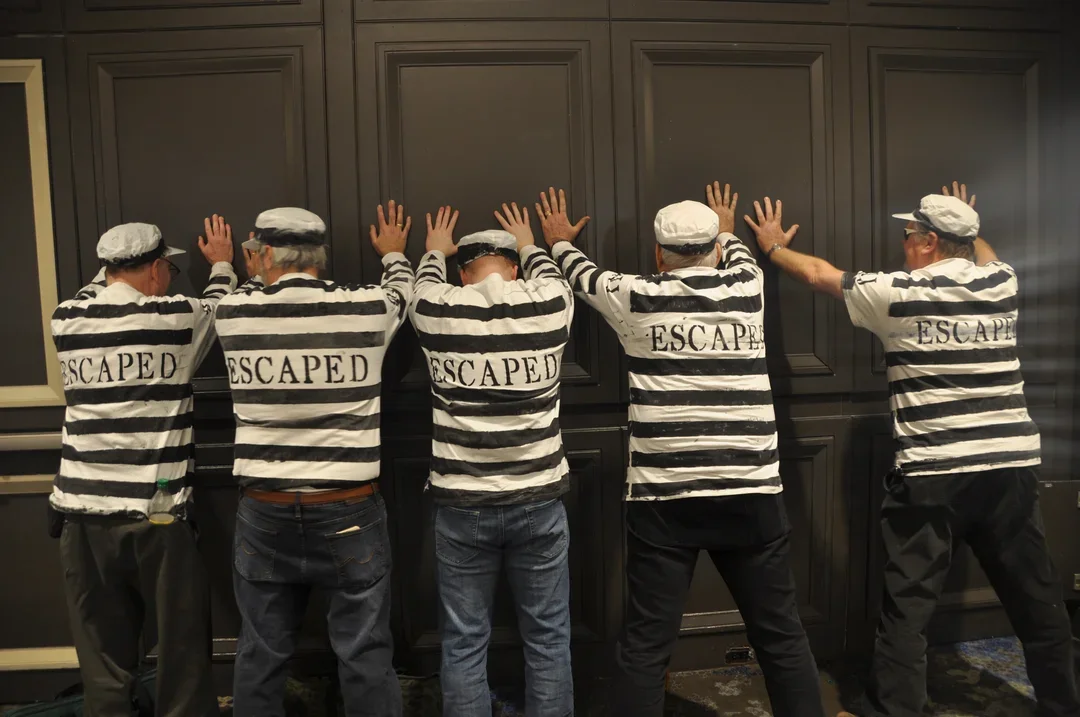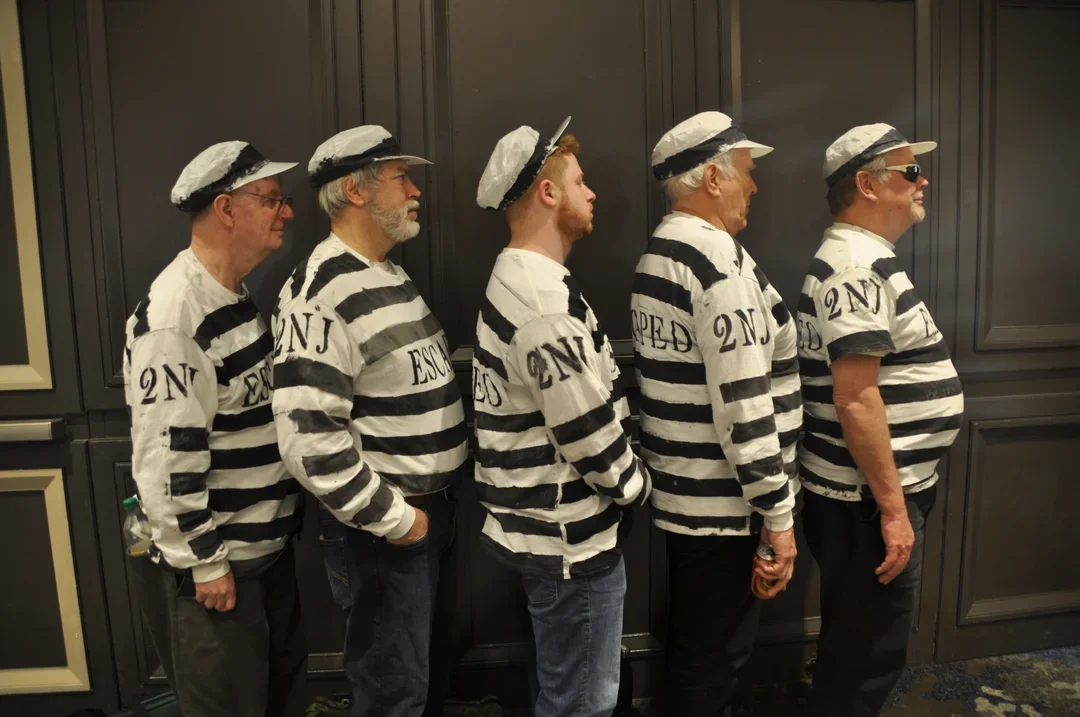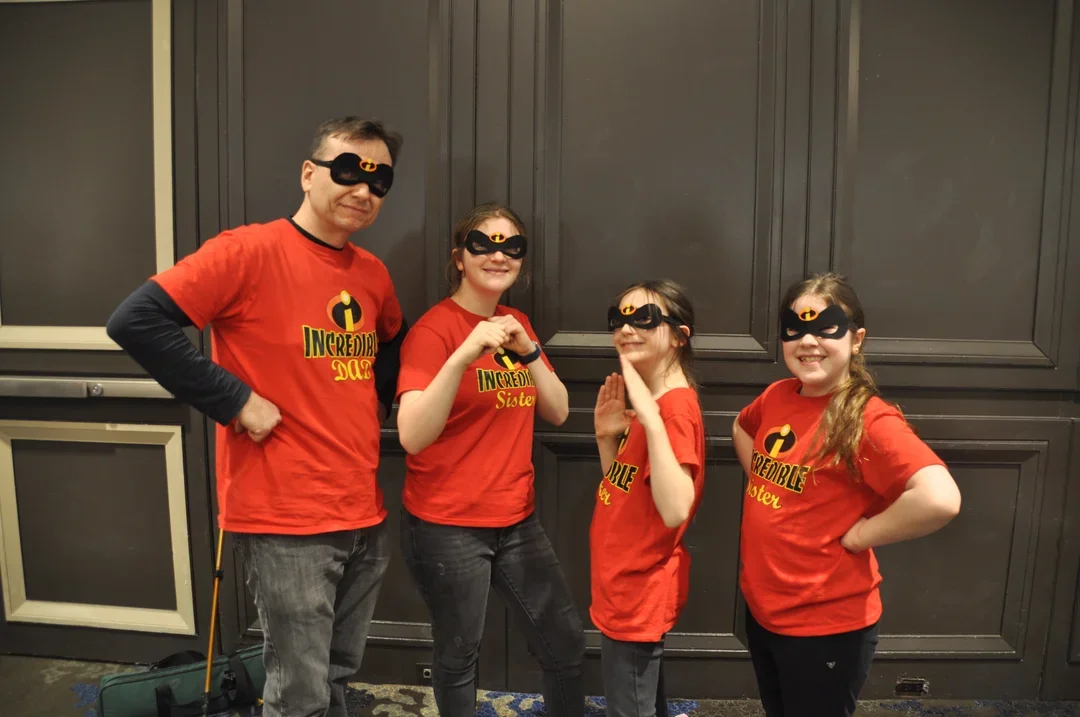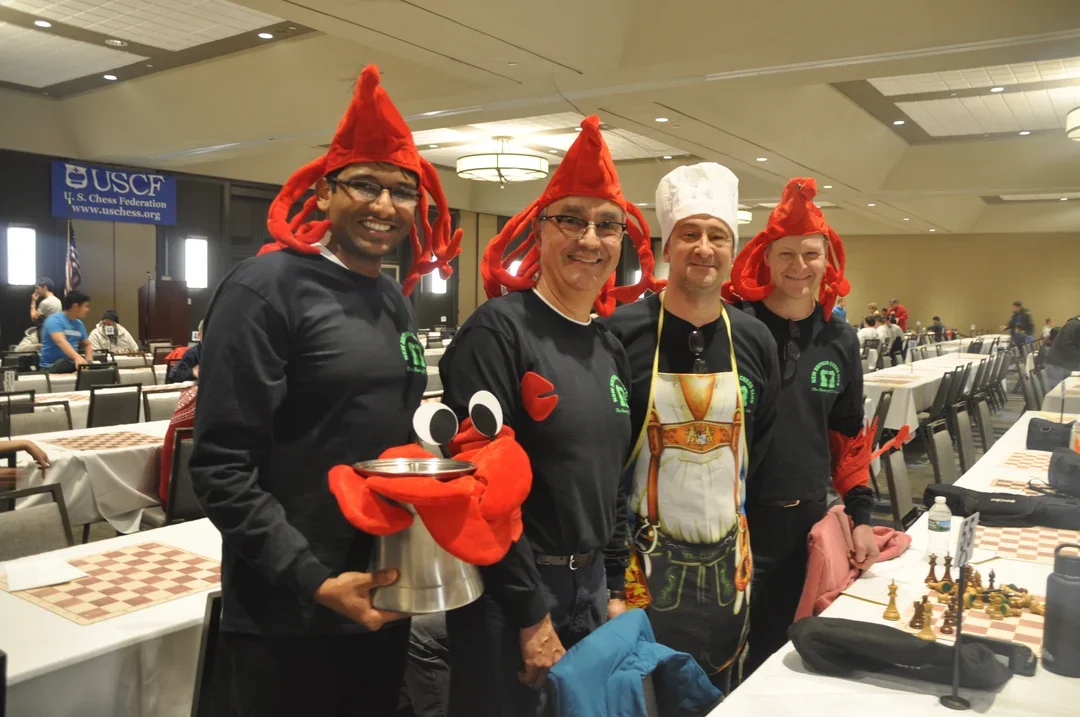A handful of last-round players are hunched over lower boards in the huge ballroom, like lonely hangers-on after a celebrity wedding reception. But across the room, pressing against the stanchions that shelter the place of honor, Board 1 of Table 1, spectators still cluster, watching the matchup that will determine who’s the bride and who’s a bridesmaid—metaphorically speaking, that is.
Princeton Orange (with an average rating of 2191), the only team with a perfect score of 5-0 going into the sixth and final round, was paired with Connecticut’s Finest (2197), one of five teams with 4 1/2. In the first game of the matchup to finish, Connecticut’s William Torres got the better of Princeton’s Daniel Moreno on Board 4, putting Princeton in the hole. To win, the squad now had to score at least 2 1/2 out of the three games still in play. But then Princeton’s FM Ethan Li drew NM Ian Harris on Board 2, while on Board 3, Princeton Expert Zachary Holecek beat Connecticut Expert Joseph Bihlmeyer.
So, it was all in the hands, and brains, of the two teams’ top players, FM Kapil Chandran for Princeton Orange and NM Arslan Otchiyev for Connecticut’s Finest. Any result on Table 1 other than a “Princeton Orange” win would throw the title up for grabs in a tiebreak calculation. With three of the four-player teams already turning in scores of 5 1/2, there was a lot of anxious self-interest. And the board position was rife with missteps for both.
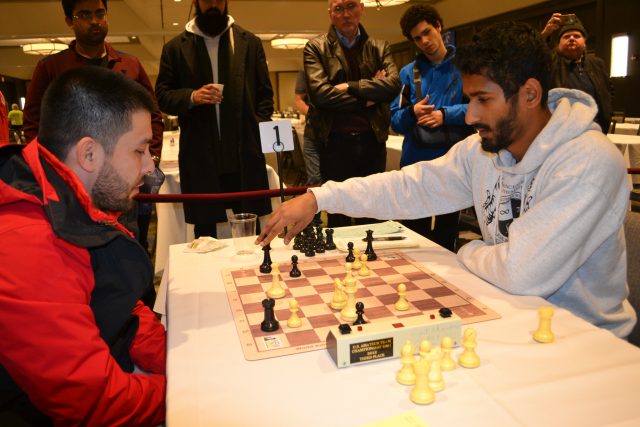 Chandran-Otchiyev postmortem (photo Al Lawrence)
Chandran-Otchiyev postmortem (photo Al Lawrence)
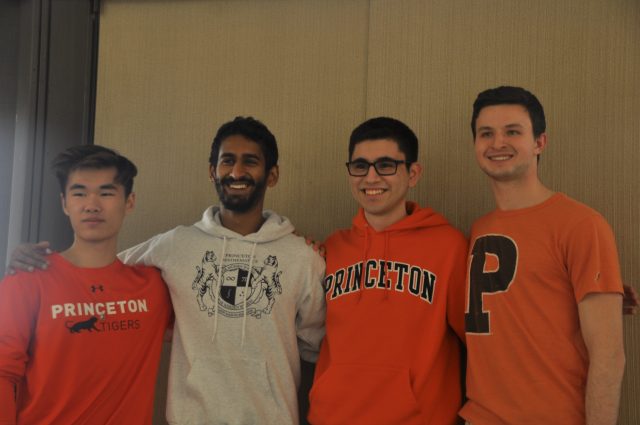 L to R: Ethan Li, Kapil Chandran, Daniel Moreno, Zachary Holecek. (photo Diane Somers)
“USATE was a very difficult event that we were able to win because of our team's great resilience and a pinch of luck,” Chandran said. “In several rounds of the tournament we went down 0-1 early in a match. Each time, we had to fight hard to hang in there, resurface, and eventually swing the match around.” The four weren’t the only Princeton students to do well. “Overall, the 12 Princeton players were very happy to participate in USATE 2019, and of course we were thrilled to take home the 1st and 3rd places.”
Here’s how the top teams finished:
L to R: Ethan Li, Kapil Chandran, Daniel Moreno, Zachary Holecek. (photo Diane Somers)
“USATE was a very difficult event that we were able to win because of our team's great resilience and a pinch of luck,” Chandran said. “In several rounds of the tournament we went down 0-1 early in a match. Each time, we had to fight hard to hang in there, resurface, and eventually swing the match around.” The four weren’t the only Princeton students to do well. “Overall, the 12 Princeton players were very happy to participate in USATE 2019, and of course we were thrilled to take home the 1st and 3rd places.”
Here’s how the top teams finished:
 Chandran-Otchiyev postmortem (photo Al Lawrence)
Chandran-Otchiyev postmortem (photo Al Lawrence)[pgn]
[Event "US Amateur Team East"]
[Site "?"]
[Date "2019.02.18"]
[White "Chandran, Kapil"]
[Black "Otchiyev, Arslan"]
[Result "1-0"]
[ECO "D16"]
[Annotator "Chandran, K"]
[PlyCount "131"]
[EventDate "2019.??.??"]
1. d4 d5 2. c4 c6 3. Nf3 Nf6 4. Nc3 dxc4 5. a4 Bg4 6. Ne5 Nbd7 7. Nxg4 Nxg4 8.
e3 (8. e4 Ngf6 (8... e5 9. Qxg4 exd4) 9. Bxc4 e6 (9... e5 10. Qb3) 10. e5 Nd5
11. O-O) 8... Ngf6 9. Bxc4 e6 (9... e5 10. Qb3) 10. O-O (10. a5) 10... Bb4 11.
Qb3 Qb6 12. Bd2 a5 13. Rfd1 O-O 14. Rac1 Rfd8 {[%csl Gf7][%cal Gc4f7]} (14...
Rad8) 15. Be1 Be7 16. Qa2 Nf8 17. f3 Bd6 18. Bf2 Qc7 19. g3 Qe7 20. e4 Bb8 21.
Kg2 Ba7 22. Qb3 Rd7 23. Ne2 Rad8 24. Be1 b6 (24... Bxd4 25. Bxa5 (25. Nxd4 Rxd4
26. Rxd4 Rxd4 27. Bxa5) 25... Ra8 (25... b6 26. Nxd4 {[%cal Gd4c6]}) 26. Bb4 c5
(26... Bc5 27. Bxc5 Qxc5 28. Bxe6) 27. Nxd4 cxb4 28. Bb5 Rdd8 29. Nc2) 25. Bf2
Ne8 26. Ba6 Nc7 27. Bd3 (27. Bb7 c5 28. dxc5 (28. Bc6 Rd6 29. dxc5) 28... bxc5
{and the bishop on b7 is awkward}) 27... c5 (27... e5 28. dxe5 Qxe5 29. Rxc6)
28. dxc5 bxc5 29. Be1 Rb8 30. Qc2 Bb6 31. Bc4 (31. Nc3 {rejected this move
because I wanted to keep Nc1-b3 possibilities alive}) 31... Rbd8 32. Nc3 Rd4
33. b3 Nd7 34. Bf2 Rxd1 35. Nxd1 (35. Rxd1 Ne5 36. Nb5 (36. Bb5)) 35... Qd6 36.
Nb2 e5 37. Rd1 Qe7 38. Qc3 Rb8 39. Bb5 (39. Qd2 {[%cal Gd2d6,Gd6c6]}) 39...
Nxb5 40. axb5 Nf8 41. Na4 (41. Rd5 Qe8 42. Qc4 Ne6) 41... Qe8 42. Qc4 Ne6 (
42... Bc7 43. Nc3 Ne6 44. Rd5) 43. Rd6 Bd8 (43... Bc7 44. Rc6) 44. b6 (44. Rc6
Nc7) (44. Nxc5 Be7 (44... Nxc5 45. Bxc5 Rxb5 46. Qxb5) 45. Rc6) 44... Be7 45.
Rxe6 (45. Rd5 Bd8 46. Bxc5 {was definitely simpler}) 45... fxe6 46. Qxe6+ Qf7
47. Qxe5 Rb7 48. Bxc5 Bxc5 49. Qxc5 Rb8 50. Qb5 h5 51. Nc5 (51. h4 {was a good
practical solution to stop black's counterplay} Qf6 52. Qxa5) 51... h4 52. b7
h3+ 53. Kf2 (53. Kxh3 Qxf3 54. Nd7 Rxb7 55. Qxb7 Qh5+ 56. Kg2 Qe2+) 53... Qf6
54. Qc4+ (54. Nd7 Qb2+ 55. Ke3 Qc3+ 56. Kf4 Qc7+ {I rejected this line at this
point, but didn't realize that white still wins the exchange} 57. Kg4 Qxb7 58.
Qc4+ Kh7 59. Nxb8) 54... Kh7 55. Qd5 Qb2+ 56. Ke3 Qc1+ 57. Kd4 Qb2+ (57... Qd2+
58. Ke5 Qxh2 (58... Qg5+ 59. Kd6 Rd8+ 60. Nd7) 59. Kf4 Rf8+ (59... Qg2 60. Qf5+
) 60. Kg4 Qf2 61. Qh5+ Kg8 62. Kxh3) (57... Rd8 58. Qxd8 Qd1+ 59. Nd3 {was a
scare that I calculated when playing 54.Qc4+}) 58. Kd3 Qb1+ 59. Kc4 Qc2+ 60.
Kb5 Qxh2 61. Qf5+ g6 (61... Kh8 62. Qc8+) (61... Kh6 62. Qf4+) 62. Qf7+ Kh6 (
62... Kh8 63. Qf6+ Kh7 64. Kc6 Qg2 (64... Qxg3 65. Ne6) 65. Kc7 Rxb7+ 66. Kxb7)
63. Qf4+ Kh7 64. Qxb8 Qe2+ 65. Kc6 h2 66. Qc7+ 1-0
[/pgn]
After 66 moves and the resolution of all the other games, the four Princeton students had won the 49th annual iteration of the U.S. Amateur Team East Championship with a perfect 6-0 score. Connecticut’s Finest, after a great run, had to settle for Top Connecticut team (justifying their choice of name).
 L to R: Ethan Li, Kapil Chandran, Daniel Moreno, Zachary Holecek. (photo Diane Somers)
L to R: Ethan Li, Kapil Chandran, Daniel Moreno, Zachary Holecek. (photo Diane Somers)- Princeton Orange (6-0) – Denis Barry Award
- Chess NYC 1st Kings (5 1/2-1/2)
- Princeton Black (5 1/2-1/2)
- Tuhnm's Triple Threat 5 1/2-1/2)
- The Rook of Mormon (5-1)
[pgn]
[Event "US Amateur Team East"]
[Site "?"]
[Date "2019.02.16"]
[White "Fedorowicz, John"]
[Black "Times, Lawyer"]
[Result "1-0"]
[ECO "A77"]
[Annotator "Fedorowicz,J"]
[PlyCount "63"]
[EventDate "2019.??.??"]
[SourceDate "2019.02.18"]
1. d4 {I've played in this event for the first time in 1974. I was on a team
from the Westfield Nj Chess club with a couple of other youngsters incuding my
friend Mark Pinto. Our team was called "The Westfield Pawns." It's always fun
and Steve Doyle,Carol Jarecki,Joe Ippolito and others do an unbelievable job
putting on a great show.} Nf6 2. c4 c5 3. d5 e6 4. Nc3 exd5 5. cxd5 d6 6. Nf3
g6 {I think the Benoni has come on hard times for many years now} 7. Nd2 Bg7 8.
e4 Nbd7 9. Be2 a6 (9... O-O 10. O-O Re8 11. a4 Ne5 12. Ra3 g5 13. Qc2 a6 14.
Nd1 $1 b6 15. g3 g4 16. Qb1 Ra7 17. b4 Rae7 18. bxc5 bxc5 19. Rb3 Ned7 20. Ne3
Ne5 21. Rb8 Qc7 22. Rxc8 $1 {Totally obsessed with getting an N into f5--not
to mention light square control!} Qxc8 23. Nf5 Rd7 24. Bb2 Bf8 25. Qc1 h6 26.
Nc4 Kh7 27. Bxe5 dxe5 28. Nb6 Qb7 29. Nxd7 Qxd7 30. Qc2 Qa7 31. Rb1 c4 32. Qxc4
Bc5 33. Kg2 a5 34. d6 Rd8 35. Ne7 {1-0 Fedorowicz,J (2560)-Norwood,D (2460)/
London 1988}) 10. a4 O-O 11. O-O Re8 12. Ra3 $1 {I was lucky enough to play my
first Lone Pine in 1976. On the off days, I would head, with my notebook, to
the tournament room where the famous GMs would hang out. One of the questions
I asked about the game below was "What does Ra3 do?" Petrosian smiled at me
and said " Nothing." Well, that's not absolutely true ... from a3 the rook
keeps a long distance watch on the kingside. A typical type of prophylactic
move GM Petrosian was famous for} b6 (12... Rb8 13. a5 Qc7 14. h3 b5 15. axb6
Rxb6 16. Qc2 Ne5 17. f4 Ned7 18. Kh1 Rb4 19. b3 $1 {Solidifying the c4-square,
but i was still shocked by this move. Look at the Ra3 now} Nb6 20. Bb2 Qe7 21.
Raa1 Ng4 22. Bxg4 Bxg4 23. Na2 Be2 24. Bxg7 Bxf1 25. Nxb4 Bb5 26. Nc6 Bxc6 27.
dxc6 Kxg7 28. Rxa6 Nc8 29. Qc3+ Kg8 30. Qd3 Qh4 31. Qf1 Ne7 32. c7 Rc8 33. Rxd6
Rxc7 34. Kh2 Rc8 35. g3 Qh5 36. g4 Qh6 37. e5 Rb8 38. Qf2 Rb4 39. Kg3 Kg7 40.
Qe3 Kh8 41. Rd8+ Kg7 42. Ne4 Nc6 43. Rc8 g5 {1-0 Petrosian,T (2635)-Quinteros,
M (2540)/Lone Pine 1976} 44. Nxg5 {Wins with many threats to black's position})
13. Kh1 h5 14. f4 Nf8 15. h3 Ng4 16. Nf3 $1 {I felt that White was already
winning. Now hxg4 is winning a piece.} (16. hxg4 $4 Qh4+ 17. Kg1 Bd4+) 16...
Nh6 (16... Nf6 17. e5 dxe5 18. fxe5 N6d7) 17. Bd3 Ra7 18. Bd2 Rc7 19. Qc1 Kh7
20. f5 $1 {With an unexpected threat of f6.} c4 $6 {Black pays for making the
d4-square available to white's N.} (20... Bb7 21. f6 Qxf6 22. Bg5) (20... f6 $5
{The Nd4 into e6 is out and White must find another way in. Black has much
better defensive chances here. I felt that i could be patient here and build
up. I was undecided but was leaning towards 21 Qd1, keeping up the pressure
and looking at h5.} 21. Ng5+ $5 fxg5 22. Bxg5 Qd7 23. f6) 21. Bc2 f6 22. Nd4 g5
23. Ne6 Nxe6 24. fxe6 {Opening the b1-h7 diagonal persuaded me to make this
recapture.} Rh8 25. e5+ Kg8 26. exf6 Bxf6 27. Ne4 Be7 28. Nxg5 Bb7 29. Nf7 {
Black resigned here...Hey Tigran...check out this Ra3!} Nxf7 30. exf7+ Kg7 31.
Rg3+ Kf8 32. Bh6+ {Was forced mate} 1-0
[/pgn]
Huuuge crowd, largest ever, period!
The annual World Amateur Team is the original and by far the largest of the regional Amateur Teams. In fact, it is about the size of the Chess Olympiads, even counting both men’s and women’s teams in that biennial event. This year, the USATE drew 1352 players to form 323 teams (teams are permitted alternates). Teams are limited to an average rating of their top four players but can stack their lineups in any way that brings about a rating under 2200, except that there’s a rule against more than two GMs on a squad, and boards must be in strict rating order—unlike in the PanAms, where teams can swap boards within a 50-point range.
Because of its heritage and attendance, the tournament also received official designation as the World Amateur Team Championship. Those who win the event receive the Denis Barry Award, named after the event’s long-time organizer and past president of US Chess.
The popular event draws faithful returnees and new players alike, who come for the fun of fighting for a team. No cash prizes are awarded, but there are lots of clocks and plaques for division winners.
Under 2100: Masters of the Exchange
Under 2000: We Won't Come Short of Winning
Under 1900: Li Kingsmen
Under 1800: Draw Blood Not Chess
Under 1700: Magbutt Fartlessons
Under 1600: Cornell B
Under 1500: Team Salami
Under 1400: AcademyTY
Under 1300: Team Innovation Center
Under 1200: Can You Don't
Under 1000: Hopkins School Grey
Two Teams tied for Top Scholastic Team, the Collins Award, named after Bobby Fischer’s famous chess teacher John Collins: Stonewall Defense Shutdown and ZZZ … Quiet Moves. Top Seniors (over 50) was won by Senior Blues No Way. Best Family (four family members) was Chess Fun Way.
There are lots of other prizes at the “The Team.” You can see them all, as well as complete results online at https://njscf.org/2019usate.
Names and Gimmicks
Part of the fun Organizer and former US Chess president E. Steven Doyle always folds into the event is a Sunday afternoon polling on the Best Team Name and Best Gimmick. Doyle proves he could easily emcee a TV gameshow, as he elicits laughter and a vote by applause in the packed hall. The Best Gimmick can be costumes, songs, poems, stand-up—or any combination.=
This year Magnus Smoked Caruana was best name, if not entirely accurate history. Runner up was Brett Kavanaugh Touched My Queen. I noticed some other contenders reflecting contemporary topics: Black Pawnther, Can’t Shut Down this Fed (GM Fedorowicz’ squad), Fake Moves, If We Don’t Win It’s Rigged, and, very on-point, given the fact that E. Steven Doyle retired from his position as senior vice president of Aetna and is now the newly elected mayor of his home town—Rules According to Doyle. (For those under 40, a reference to the most famous game rule-compiler of all time, Hoyle.) Prawn Sacrifice won a very competitive vote for Best Gimmick.
Doyle’s organizing staff runs one of the biggest tournaments in the world without a hitch: six on-schedule rounds of serious chess punctuated by silly fun, door prizes, and socializing. Steve’s talented crew always deserves our public thanks: Ken “Bowtie” Ballou, Bill Bluestone, Noreen Davisson, Bernadette Doyle, Dov Gorman, Joe Ippolito, Carol Jarecki, Aaron Kiedes, Justine Kohler, Jabari McGreen, Sophia Rohde, Harold Scott, Mike Somers, and Harold Stenzel. They handle the complicated task with good humor and expertise.
Next year, the USATE celebrates its 50th anniversary. “We’ll have lots of special extras,” Doyle teases. And, if I know the Mayor, he’ll deliver what he promises.Categories
Archives
- December 2025 (11)
- November 2025 (29)
- October 2025 (39)
- September 2025 (27)
- August 2025 (29)
- July 2025 (43)
- June 2025 (25)
- May 2025 (24)
- April 2025 (29)
- March 2025 (29)
- February 2025 (20)
- January 2025 (24)
- December 2024 (34)
- November 2024 (18)
- October 2024 (35)
- September 2024 (23)
- August 2024 (27)
- July 2024 (44)
- June 2024 (27)
- May 2024 (31)
- April 2024 (51)
- March 2024 (34)
- February 2024 (25)
- January 2024 (26)
- December 2023 (29)
- November 2023 (26)
- October 2023 (37)
- September 2023 (27)
- August 2023 (37)
- July 2023 (47)
- June 2023 (33)
- May 2023 (37)
- April 2023 (45)
- March 2023 (37)
- February 2023 (28)
- January 2023 (31)
- December 2022 (23)
- November 2022 (32)
- October 2022 (31)
- September 2022 (19)
- August 2022 (39)
- July 2022 (32)
- June 2022 (35)
- May 2022 (21)
- April 2022 (31)
- March 2022 (33)
- February 2022 (21)
- January 2022 (27)
- December 2021 (36)
- November 2021 (34)
- October 2021 (25)
- September 2021 (25)
- August 2021 (41)
- July 2021 (36)
- June 2021 (29)
- May 2021 (29)
- April 2021 (31)
- March 2021 (33)
- February 2021 (28)
- January 2021 (29)
- December 2020 (38)
- November 2020 (40)
- October 2020 (41)
- September 2020 (35)
- August 2020 (38)
- July 2020 (36)
- June 2020 (46)
- May 2020 (42)
- April 2020 (37)
- March 2020 (60)
- February 2020 (38)
- January 2020 (45)
- December 2019 (34)
- November 2019 (35)
- October 2019 (42)
- September 2019 (45)
- August 2019 (56)
- July 2019 (44)
- June 2019 (35)
- May 2019 (40)
- April 2019 (48)
- March 2019 (61)
- February 2019 (39)
- January 2019 (30)
- December 2018 (29)
- November 2018 (51)
- October 2018 (45)
- September 2018 (29)
- August 2018 (49)
- July 2018 (35)
- June 2018 (31)
- May 2018 (39)
- April 2018 (31)
- March 2018 (26)
- February 2018 (33)
- January 2018 (30)
- December 2017 (26)
- November 2017 (24)
- October 2017 (30)
- September 2017 (30)
- August 2017 (31)
- July 2017 (28)
- June 2017 (32)
- May 2017 (26)
- April 2017 (37)
- March 2017 (28)
- February 2017 (30)
- January 2017 (27)
- December 2016 (29)
- November 2016 (24)
- October 2016 (32)
- September 2016 (31)
- August 2016 (27)
- July 2016 (24)
- June 2016 (26)
- May 2016 (19)
- April 2016 (30)
- March 2016 (36)
- February 2016 (28)
- January 2016 (32)
- December 2015 (26)
- November 2015 (23)
- October 2015 (16)
- September 2015 (28)
- August 2015 (28)
- July 2015 (6)
- June 2015 (1)
- May 2015 (2)
- April 2015 (1)
- February 2015 (3)
- January 2015 (1)
- December 2014 (1)
- July 2010 (1)
- October 1991 (1)
- August 1989 (1)
- January 1988 (1)
- December 1983 (1)


